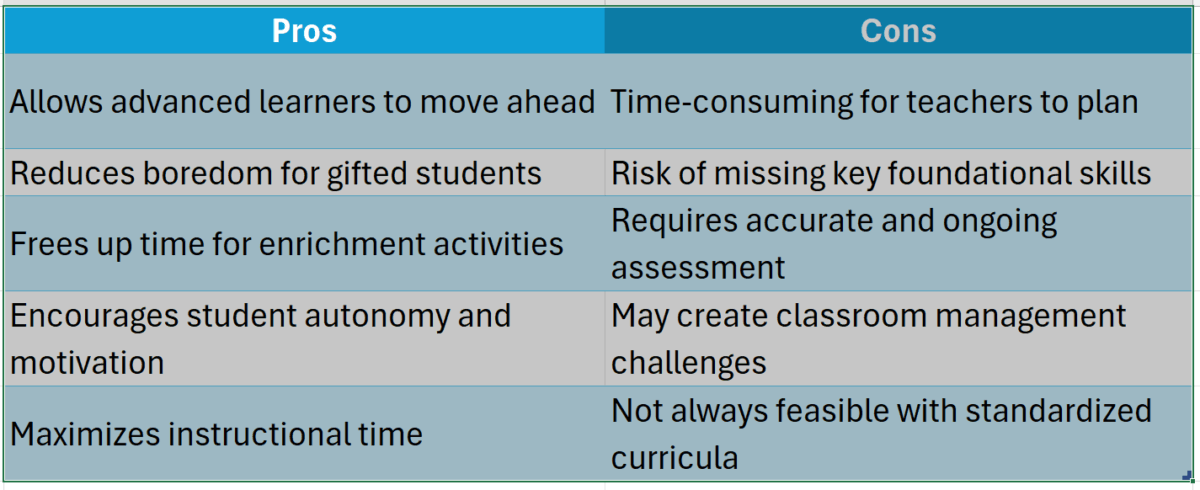
Curriculum compacting is an innovative approach that tailors education to meet the unique needs of gifted students. By streamlining the curriculum, educators can provide these learners with the challenges they crave, allowing them to explore subjects in greater depth. This method not only keeps them engaged but also fosters a love for learning.
What is Curriculum Compacting?
Curriculum compacting involves assessing students’ knowledge and skills to eliminate redundant content. This means gifted students can skip over material they already understand and focus on advanced topics. It’s like having a personalized learning path that accelerates their education!
Benefits of Curriculum Compacting
- Enhanced Engagement: Gifted students often feel bored in traditional classrooms. Compacting keeps them motivated.
- Deeper Learning: With more time to explore complex subjects, students can dive into data science, AI, and machine learning.
- Differentiated Education: This approach ensures that every student receives the right level of challenge, promoting equity in learning.
By implementing curriculum compacting, educators can unlock the full potential of gifted students, paving the way for future innovators.
Unlock your potential with online degrees—Learn more!
What is Curriculum Compacting and How Does It Work?

Curriculum compacting is an innovative strategy aimed at supporting gifted students by optimizing their learning experiences. This approach enables educators to assess what students already know, allowing them to adjust the curriculum accordingly. As a result, gifted learners can tackle more challenging material, keeping them motivated and engaged in their education.
What is Curriculum Compacting?
Curriculum compacting assesses students’ knowledge to remove redundant content. If a student understands a topic, they can skip it and progress to more advanced concepts. This method is a vital part of differentiated education, allowing students to learn at their own pace.
How Does It Work?
- Assessment: Teachers utilize data science techniques to gauge students’ understanding.
- Customization: The curriculum is tailored using AI and machine learning based on these assessments.
- Engagement: Gifted students can explore subjects that interest them, nurturing a passion for learning.
By adopting curriculum compacting, schools can effectively support gifted students, providing them with the challenges they seek while enhancing the overall learning environment.
The Benefits of Curriculum Compacting for Gifted Learners
Curriculum compacting is an effective strategy that supports gifted students by customizing their learning experiences. By streamlining the curriculum, educators can focus on the unique needs of advanced learners, keeping them engaged and fostering a passion for learning essential for academic success.
Key Benefits of Curriculum Compacting
- Personalized Learning: Gifted students can skip familiar material, allowing them to concentrate on new and challenging concepts.
- Increased Engagement: Tailored lessons that align with their interests help maintain motivation and excitement about school.
- Enhanced Critical Thinking: Deeper exploration of subjects sharpens analytical skills, preparing students for future studies in areas like data science, AI, and machine learning. Integrating curriculum compacting into differentiated education not only aids gifted students but also enhances the overall classroom experience.
By utilizing data to assess students’ strengths and weaknesses, teachers can provide necessary support, creating a dynamic learning environment where all students can thrive.
How Does Curriculum Compacting Foster Independence in Students?
Curriculum compacting is an effective educational strategy, particularly for gifted students. It enables them to progress at their own pace, emphasizing deeper understanding over rote learning. This method not only acknowledges their advanced skills but also promotes independence, essential for their development.
Allowing students to compact their curriculum gives them the freedom to engage with material in a way that suits them. This autonomy fosters ownership of their learning journey. Key benefits include:
- Personalized Learning: Students can bypass familiar content and explore new subjects.
- Critical Thinking: They develop skills in analysis and synthesis, vital for areas like data science, AI, and machine learning.
- Self-Directed Goals: Gifted learners establish their own objectives, boosting motivation and accountability. Integrating curriculum compacting into differentiated education creates a more stimulating environment.
Students are empowered to pursue their interests and cultivate skills that will benefit them in the future, ultimately preparing them for a world that values independence and innovation.
Is Curriculum Compacting Effective for All Gifted Students?
Curriculum compacting is an effective strategy designed to meet the unique needs of gifted students. By streamlining the curriculum, teachers can offer more challenging material, enabling deeper exploration of subjects. But is this method suitable for all gifted learners? Let’s explore!
Understanding Curriculum Compacting
Curriculum compacting assesses what students already know and removes redundant material. This approach is especially beneficial for gifted students, allowing them to focus on advanced topics that spark their curiosity. With advancements in data science, AI, and machine learning, educators can analyze student performance to ensure personalized and effective compacting.
Benefits of Curriculum Compacting
- Engagement: Gifted students often find standard lessons boring. Compacting keeps them engaged with challenging content.
- Time Efficiency: By skipping material they already understand, students can dedicate more time to subjects that excite them.
- Differentiated Education: This method serves as a form of differentiated education, addressing the diverse needs of gifted learners.
Overall, curriculum compacting can significantly benefit many students, but it’s crucial to customize it to each learner’s strengths and interests.
Tailoring Curriculum Compacting: Strategies for Diverse Learning Needs
Curriculum compacting is an effective strategy that empowers gifted students to learn at their own pace. This approach is crucial as it acknowledges that students have different learning styles and speeds. By customizing the curriculum, we can keep gifted learners engaged and challenged instead of bored.
- Identify Learning Gaps: Utilize data science to evaluate each student’s strengths and weaknesses, helping teachers understand what students know and what they need to learn.
- Flexible Grouping: Organize students by interests and abilities, enabling differentiated education where gifted students can collaborate with like-minded peers.
- Incorporate AI and Machine Learning: Use technology to personalize learning experiences. AI can adjust lessons in real-time, ensuring gifted students remain challenged and engaged.
By adopting these strategies, educators can foster a vibrant learning environment. Curriculum compacting not only benefits gifted students but also nurtures a lifelong love for learning, leading to greater academic and personal success.
The Role of Teachers in Implementing Curriculum Compacting
Curriculum compacting is a powerful tool that helps gifted students thrive in their learning environments. By allowing these students to skip over material they already understand, teachers can provide a more tailored educational experience. This approach not only keeps gifted learners engaged but also fosters a love for learning.
Teachers play a crucial role in the success of curriculum compacting. They assess students’ knowledge through various methods, including tests and observations. By analyzing this data, educators can identify which concepts students have mastered, paving the way for a more personalized learning path.
Key Steps for Teachers
- Identify Student Strengths: Use data science techniques to evaluate students’ skills.
- Create a Compacting Plan: Develop a plan that outlines what content can be skipped and what will be covered.
- Incorporate AI and Machine Learning: Leverage technology to track student progress and adapt lessons accordingly.
By following these steps, teachers can effectively implement curriculum compacting, ensuring that gifted students receive the differentiated education they deserve.
Unlock your potential with online degrees—Learn more!
How Can Parents Support Curriculum Compacting at Home?
Curriculum compacting is a powerful tool that helps gifted students thrive by allowing them to skip over material they already know. This approach not only keeps them engaged but also fosters a love for learning. So, how can parents support this method at home?
Understand Your Child’s Needs
To effectively support curriculum compacting, parents should first understand their child’s unique learning style. Engage in conversations about their interests and strengths. This insight can guide you in providing differentiated education that complements what they learn in school.
Encourage Exploration
Encourage your child to explore subjects that excite them. Use resources like data science, AI, and machine learning to spark their curiosity. For instance, you could suggest online courses or fun projects that relate to these fields, making learning both enjoyable and relevant.
Real-Life Success Stories: Curriculum Compacting in Action
Curriculum compacting is a powerful tool that helps gifted students thrive. By streamlining their learning, it allows them to focus on advanced topics that truly challenge them. This approach not only keeps them engaged but also nurtures their unique talents, making education more meaningful.
Many schools have successfully implemented curriculum compacting, showcasing its benefits. For instance, a middle school in California used data science to identify students who excelled in math. They compacted the curriculum, allowing these students to explore AI and machine learning concepts earlier than their peers.
Key Benefits of Curriculum Compacting
- Enhanced Engagement: Gifted students stay motivated when they tackle challenging material.
- Personalized Learning: Each student’s strengths are recognized, leading to a tailored educational experience.
- Real-World Applications: Students can apply their skills in exciting fields like data science, preparing them for future careers.
Discover How CollegeAndTuition.com Can Enhance Your Curriculum Compacting Efforts
Curriculum compacting is a powerful tool that helps gifted students thrive in their learning environment. By streamlining the curriculum, educators can focus on what truly matters—challenging these bright minds. This approach not only enhances their educational experience but also fosters a love for learning that lasts a lifetime.
Curriculum compacting allows gifted students to skip material they already know, giving them more time to explore advanced topics. Here’s how it supports their growth:
- Personalized Learning: Tailoring lessons to fit individual needs makes learning more engaging.
- Increased Motivation: When students are challenged appropriately, they are more likely to stay interested and motivated.
- Data-Driven Decisions: Using data science, educators can identify each student’s strengths and weaknesses, ensuring effective differentiation in education.
By integrating AI and machine learning, CollegeAndTuition.com can help teachers analyze student performance and adjust the curriculum accordingly. This means that gifted students receive the right level of challenge, allowing them to excel and reach their full potential.
Unlock your potential with online degrees—Learn more!
FAQs
1. What is curriculum compacting?
Curriculum compacting is an instructional strategy that streamlines the regular curriculum to allow advanced students to move quickly through material they already know and spend more time on enrichment or advanced learning.
2. Who benefits from curriculum compacting?
It mainly benefits gifted and high-achieving students who already demonstrate mastery of grade-level content and need more challenging work.
3. How does curriculum compacting work?
Teachers assess students’ existing knowledge, eliminate content they have mastered, and replace it with more complex, interest-based, or accelerated activities.
4. What are the steps involved in curriculum compacting?
The basic steps include identifying what students already know, documenting what can be skipped, and planning alternative activities for deeper learning.
5. Does compacting mean skipping grade levels?
No, curriculum compacting adjusts the depth and pace of learning within a grade level. Skipping a grade is a separate decision involving full grade acceleration.
6. Is curriculum compacting only for gifted programs?
While commonly used for gifted students, compacting strategies can be applied more broadly to any learner who shows advanced understanding in a subject area.





